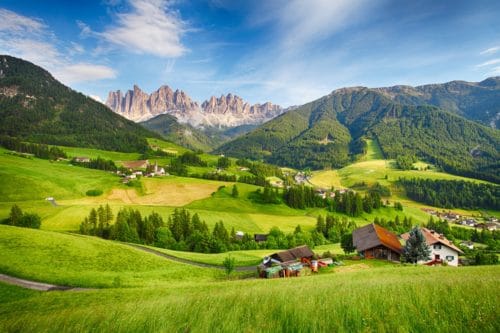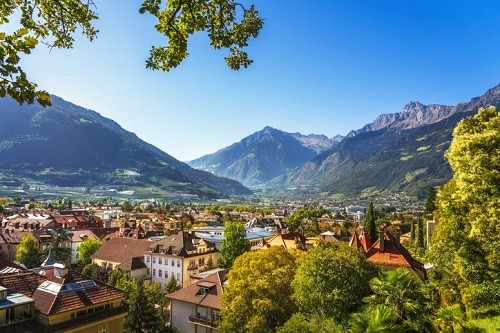Discover The Wine Region of Alto Adige in Italy
Last Updated on December 16, 2019.
Alto Adige is a picturesque destination that’s also known as South Tyrol (Südtirol) in Northern Italy, beset by the stunning mountain ranges of the Dolomites and Southern Alps. But there’s so much more to this place outside of dramatic mountain vistas. It’s also a stellar region for wine production. Given its geographical position and proximity to the borders of Switzerland and Austria, Alto Adige is able to offer a unique blend of Alpine and Mediterranean cuisine, climates and culture.
There are a multitude of ways to immerse yourself in the culture of Alto Adige, beginning at its heart and capital, Bolzano. From self-guided hiking and biking routes, to accommodation run by winemakers themselves, you can stay in a gorgeous hotel room with a mountain view at elevation for as little as 60 euros per night.
To get more information on this special place from an insider’s perspective, we spoke with the President of the Consortium of Alto Adige Wine, Eduard Bernhart.
“Both Italian and German are spoken in the region and over two-thirds of the population is native-German speaking (in fact, Alto Adige is the oldest German-speaking winegrowing area). All signs for local towns and villages and the DOCs bear names in both languages, and the mix of cultures can also be found in the region’s cuisine: speck (blending Italian and Germanic curing processes), knödel dumplings, brown breads made of wheat and rye and fruit strudels. The towering peaks of the Alps and Dolomites are in stark contrast to the Kalterer See (Lake Kaltern) a bit further south. You’ll get crisp mountain air in high altitude areas and warm, Mediterranean breezes on the valley floor near the lake.”
The Wines of Alto Adige
The diversity of the landscape is also conducive to growing around 20 different grape varieties. Two of which are indigenous to Alto Adige.
Schiava, which is the most-planted grape in the region—where it’s been growing since the 16th century—and Lagrein, whose origins are deeply rooted in Bolzano. As a light wine with moderate tannins, floral tones of violets and fresh berries, Schiava is also a popular summer wine when chilled.
Pinot Nero/Pinot Noir is also planted in the region. You can expect well-structured versions with rich notes of dark berries, clove and violet that are often amazingly close to their Burgundian counterparts.
Lagrein, one of the two indigenous grapes of the region, has a velvety fullness and soft acidity. The noble, spicy tones are accompanied by fruity berries, fresh cherries, and violets. When aged in small oak casks, Lagrein unfolds its elegant, full-bodied presence. It pairs well with beef, game, and aged cheese, notes Bernhart.
While the quality of red wine in Alto Adige can be stellar when crafted properly, the region is probably more well known as a quality white wine producing area. The most well known white variety being produced? Pinot Grigio. This variety is very adaptive to its terroir, and Pinot Grigio from Südtirol is able to show off its range of potential here given the region’s diversity in micro-climates. Bernhart describes its range of tasting notes as being “sometimes fiery and corpulent with fruity aromas of ripe apples, pears, and quince, sometimes sleek and mineral-rich with soft scent tones of linden blossoms.”
Riesling is also somewhat prominent and often associated with Südtirol, as are smaller quantities of Chardonnay, Pinot Blanc, Sylvaner and Veltliner.
Gewürztraminer is another well known variety that some producers in Alto Adige are having great success with. This floral-forward and aromatic grape can also exhibit beautiful spice tones.
“Very few people realize that Alto Adige is said to be the home of Gewürztraminer, which originated in the Italian village of Tramin. Gewürztraminer translates to “spice carrier,” since it is an aromatic variety known for notes of clove, lychee, rose petals and tropical fruit,” notes Bernhart.
Many white grape varieties in Alto Adige are grown at substantial elevation, as high as 3,300 feet above sea level. As the grapes mature throughout the growing season, they maintain an elevated acidity while also developing inviting mineralistic notes in the resulting wines.
Pinot Bianco is another variety that seems to thrive in the alpine terroir, with Bernhart saying that “Pinot Bianco feels especially at home at high elevations up to 800 m (2,600 ft.) above sea level and in Alto Adige, it has developed into a leading white variety. Its elegant scent of apples, pears, lemons, and tones of hay flowers and hazelnut make it extremely versatile.”
Things To Do in Alto Adige
Now that we’ve discussed the Wines of Alto Adige, let’s dive a bit further into what other activities a #Winetraveler can take part in in this outdoorsman’s paradise.
Hiking and biking are both popular activities throughout the local community. It’s definitely recommended that you spend as much time outside as possible. Try to soak up the sun and live in the moment by focusing on the nuances of the scent of the region. There are three primary wine routes you can expect to traverse by bicycle: the Northern Wine Route, Central Wine Route and Southern Wine Route. Each offers a different perspective and various challenges at different elevations and length. For the hiker, there are even more options. Explore various self-guided wine hikes that range in focus from historical to varietal. Guided hikes are also available throughout the region and its various communes.
If you’re going wine tasting, pay attention to the exterior architecture and interior design of each winery. Some have spent a substantial amount of resources on elaborate designs that will keep you intrigued across any wine route you choose.
As we mentioned earlier, the cuisine of Alto Adige is widely varied. You’ll find examples of traditional Italian, Austrian, Swiss and German dishes, as well as a fusion of offerings from these countries and beyond. If you’re on the lookout for traditional Südtirol plates, keep an eye out for knodel and spek.
Another option if you’re looking to get some exercise outside is to go sailing, pedal boating or even windsurfing on the stunning Kalterer See. Fishing on the lake itself is also quite good, and you’ll get to haul in species ranging from carp, to perch and even eel, all while taking in dramatic mountain views. Note that a fishing license is required to fish on the lake as is a day ticket. Both can be acquired via the Tourist Association of Kaltern website.
If you’re a Winter Winetraveler, there are upwards of 30 different ski areas located throughout Alto Adige.
Where To Stay in Alto Adige
Fancy wine-focused accommodation? Vinum Hotels — a 29 family-run operation in the heart of Alto Adige’s wine growing area is managed solely by passionate wine enthusiasts. This is truly one of the best ways to experience Alto Adige if you’re a wine lover, and your hosts will seek to enhance your experience further by combining vineyard and cellar tour experiences, with world-class wine tastings, outdoor activities, health spas and beyond.
More Ways To Explore Italy
10 Charming Italian Towns To Visit If You Love Food & Wine
Sardinia Itinerary: Key Sardinian Wineries To Visit & Bottles to Find at Home
Collio: One of the Most Unique White Wine Regions of the World
Franciacorta Itinerary: How To Spend a Week in Northern Italy
Campania: Fall in Love With the Aglianico Grape Variety
Written By Greig Santos-Buch
Greig Santos-Buch is a Co-Founder at Winetraveler.com and a WSET 2 Merit Sommelier. He works with several brands focusing on experiential and immersive-style travel. In his spare time, you can find him hiking with a bottle of Cabernet Franc in his backpack or scuba diving trying to talk a reef shark into trying Swiss wine.


